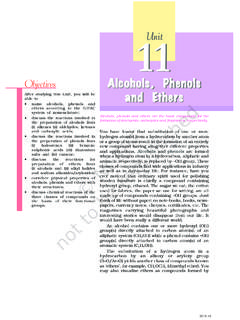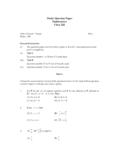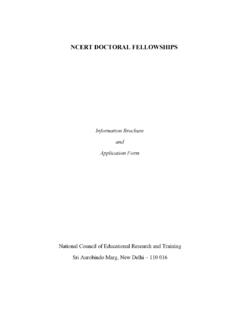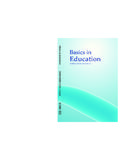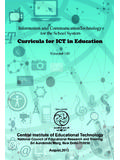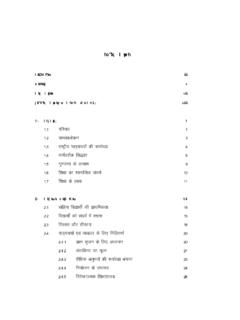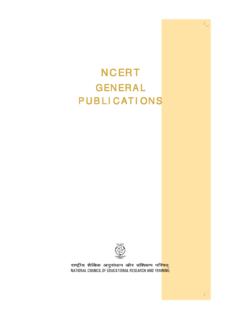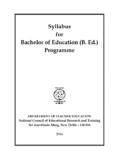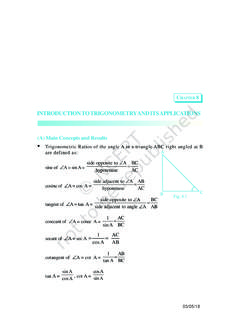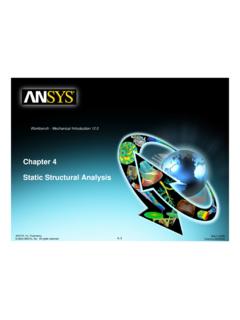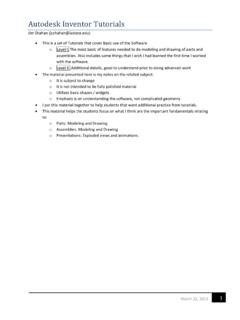Transcription of PRACTICAL GEOMETRY SYMMETRY AND AND …
1 Let a line l and a point P not lying on it be given. By using propertiesof a transversal and parallel lines, a line which passes through thepoint P and parallel to l , can be drawn. A triangle can be drawn if any one of the following sets ofmeasurements are given :(i)Three sides (SSS).(ii)Two sides and the angle between them (SAS).(iii)Two angles and a side (AAS) or (ASA).(iv)The hypotenuse and a leg in the case of a right-angled triangle(RHS). A figure has line SYMMETRY , if there is a line about which the figure maybe folded so that the two parts of the figure will coincide with each other.
2 Regular polygons have equal sides and equal angles. They havemultiple ( , more than one) lines of SYMMETRY . Each regular polygon has as many lines of SYMMETRY as it has sides. Mirror reflection leads to SYMMETRY , under which the left-rightorientation have to be taken care Rotation turns an object about a fixed point. This fixed point iscalled the centre of rotation. The angle by which the object rotates is the angle of rotation. Rotationmay be clockwise or anti-clockwise. A half-turn means rotation by 180 . A quarter-turn means rotation by 90 . If, after a rotation, a figure or an object coincides with the originalposition, we say that it has a rotational SYMMETRY .
3 In a complete turn (of 360 ), the number of times. the figure coincideswith its original position is called its order of rotational SYMMETRY . Every figure has a rotational SYMMETRY of order 1 ( a rotationalsymmetry of angle 360 ). In such a case it is considered that thefigure has no rotational SYMMETRY . Some shapes have only one line of SYMMETRY , like the letter E; somehave only rotational SYMMETRY , like the letter S; and some have bothvertical and horizontal lines of SYMMETRY , like the letter H. Plane figures are of two-dimensions (2-D) and the solid shapes areof three-dimensions (3-D).
4 The corners of a solid shape are called its vertices, the line segments/curves which form its skeleton are its edges and its flat surfaces areits A net is a skeleton-outline of a solid that can be folded to make the solid. Solid shapes can be drawn on a flat surface. This is called a 2 Drepresentation of a 3 D solid (shape). Two types of sketches of a solid are possible:(i)An oblique sketch which does not have proportional measurements.(ii)An isometric sketch which is drawn on an isometric dot paper. Inthis sketch of the solid, the measurements are kept Different sections of a solid can be viewed in many ways:(i)By cutting or slicing, the shape, which would result in the cross-section of the solid.
5 (ii)By observing a 2-D shadow of a 3-D shape.(iii)By looking at the shape from different positions-the front-view,the side-view and the top-view. In Examples 1 to 3, there are four options, out of which one is the correct 1:Which of the following is not a symmetrical figure?(a) (b)(c)(d)Solution:Correct answer is (d).Example 2:In the word MATHS which of the following pairs ofletters shows rotational SYMMETRY (a)M and T(b)H and S(c)A and S(d)T and SSolution:Correct answer is (b).Example 3:The angle of rotation for thefigure is(a)45 (b)60 (c)90 (d)180 Solution:Correct answer is (C)In Examples 4 to 6, fill in the blanks to make it a 4:The figure has _____ vertices,_____ edges and _____ :10, 15, 7 Fig.
6 Example 5:The adjoining net in Fig. representsa :CubeExample 6:Rotation turns an object about a fixedpoint. This fixed point is called :centre of Examples 7 to 9, state whether the statements are True or 7:A net of a 3-D shape is a sort of skeleton - outline in 2-D,which, when folded results in the 3-D :TrueExample 8:A regular pentagon has no lines of :FalseExample 9:Order of rotational SYMMETRY for the figure is :FalseFig. translation slidesa figure along thedirection of a linewithout rotation turns afigure around apoint, called thecentre of reflection flips afigure across a lineto create a Example 10:Draw all the lines of SYMMETRY for the following letters ifthey Example 11:State whether the figure showsrotational SYMMETRY .
7 If yes, then what isthe order of rotational SYMMETRY ?Solution:The given figure shows rotationalsymmetry. The order of SYMMETRY = 4,which is clear from the following figure:Note: The dot is placed just to indentify different positions of the 12:Identify the following figures:(i)(ii)Fig. Solution:(i) Rectangular Pyramid(ii) Triangular PrismExample 13:Construct a triangle PQR such that PQ = 6 cm,QR = 7 cm and PR = :(i)Draw a line segment PQ of length 6cm.(ii)With P as centre, draw an arc of radius cm.(iii)With Q as centre, draw an arc of radius 7 cm whichintersects the previous arc at R.
8 (iv)Join PR and PQR is the required triangle (Fig. ).Fig. 14:Draw the top, the front and the side views of the followingsolid figure made up of Solution:Desired views are shown in Fig. belowFig. provides many beautifulexamples of SYMMETRY , such as thewings of a butterfly and a peacock orthe petals of a flower. Symmetricobjects have parts that are figure has line SYMMETRY if you candraw a line through it so that the twosides are mirror images of each line is called the line of 15:Given a line l and a point M on it draw a perpendicularMP to l where MP = and a line q parallel to lthrough SolutionFig.
9 :(i)Draw a line l.(ii)Take a point M on it.(iii)Draw an angle of 90 at M with l which isperpendicular to l at M.(iv)With M as centre and radius cm, draw anarc which intersects the above perpendicular atpoint P. MP is the required prependicular(v)At P, draw an angle of 90 with PM and produceto make a line q is the required line parallel to line l. Example 16 Determine the number of edges, vertices andfaces in the Fig. : Understand and Explore the ProblemFig. What information is given in the question?A square pyramid. What are you trying to find?
10 The number of edges. vertices and faces. Is there any information that is not needed?The measure of the edges are not a Strategy Recall the definitions of edges, vertices and faces of a 3-Dfigure and try to co-relate them to the figure given The different plain regions are called faces. Hence, thereare 5 faces. The line segments formed, where the faces meet are callededges. Hence, there are 8 edges. Edges meet at a point which are called vertices. Hence,there are 5 vertices. Therefore, a square pyramid has 5 faces, 5 vertices and8 edges. Revise Try to find the number of vertices and edges of a you see a pattern emerging based on your findings?
